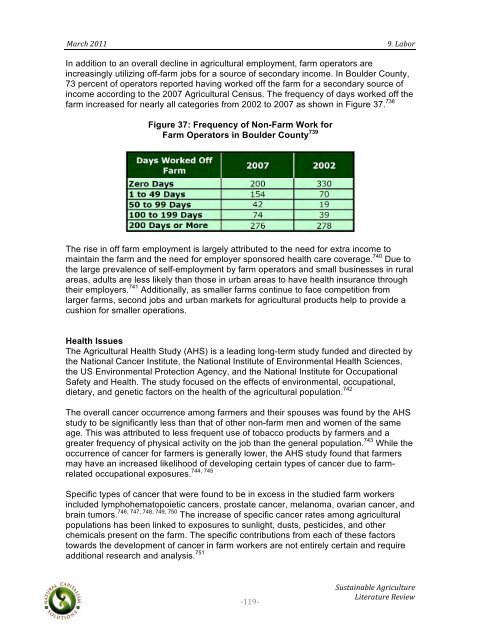Sustainable Agriculture Literature Review - Boulder County
Sustainable Agriculture Literature Review - Boulder County
Sustainable Agriculture Literature Review - Boulder County
You also want an ePaper? Increase the reach of your titles
YUMPU automatically turns print PDFs into web optimized ePapers that Google loves.
! !!<br />
"#$%&!'())!! !!!!!!!!!!!!!!!!!!!!!!!!!!!!!!!!!!!!!!!!!!!!!!!!!!!!!!!!!!!!!!!!!!!!!!!!!!!!!!!!!!G+!9#6-$!<br />
In addition to an overall decline in agricultural employment, farm operators are<br />
increasingly utilizing off-farm jobs for a source of secondary income. In <strong>Boulder</strong> <strong>County</strong>,<br />
73 percent of operators reported having worked off the farm for a secondary source of<br />
income according to the 2007 Agricultural Census. The frequency of days worked off the<br />
farm increased for nearly all categories from 2002 to 2007 as shown in Figure 37. 738<br />
!<br />
Figure 37: Frequency of Non-Farm Work for<br />
Farm Operators in <strong>Boulder</strong> <strong>County</strong> 739<br />
The rise in off farm employment is largely attributed to the need for extra income to<br />
maintain the farm and the need for employer sponsored health care coverage. 740 Due to<br />
the large prevalence of self-employment by farm operators and small businesses in rural<br />
areas, adults are less likely than those in urban areas to have health insurance through<br />
their employers. 741 Additionally, as smaller farms continue to face competition from<br />
larger farms, second jobs and urban markets for agricultural products help to provide a<br />
cushion for smaller operations.<br />
Health Issues<br />
The Agricultural Health Study (AHS) is a leading long-term study funded and directed by<br />
the National Cancer Institute, the National Institute of Environmental Health Sciences,<br />
the US Environmental Protection Agency, and the National Institute for Occupational<br />
Safety and Health. The study focused on the effects of environmental, occupational,<br />
dietary, and genetic factors on the health of the agricultural population. 742<br />
The overall cancer occurrence among farmers and their spouses was found by the AHS<br />
study to be significantly less than that of other non-farm men and women of the same<br />
age. This was attributed to less frequent use of tobacco products by farmers and a<br />
greater frequency of physical activity on the job than the general population. 743 While the<br />
occurrence of cancer for farmers is generally lower, the AHS study found that farmers<br />
may have an increased likelihood of developing certain types of cancer due to farm-<br />
744, 745<br />
related occupational exposures.<br />
Specific types of cancer that were found to be in excess in the studied farm workers<br />
included lymphohematopoietic cancers, prostate cancer, melanoma, ovarian cancer, and<br />
brain tumors. 746, 747, 748, 749, 750 The increase of specific cancer rates among agricultural<br />
populations has been linked to exposures to sunlight, dusts, pesticides, and other<br />
chemicals present on the farm. The specific contributions from each of these factors<br />
towards the development of cancer in farm workers are not entirely certain and require<br />
additional research and analysis. 751<br />
"''$"<br />
!,342#.5#6/1!78$.%3/23$1!<br />
9.21$#23$1!:1;.1
















